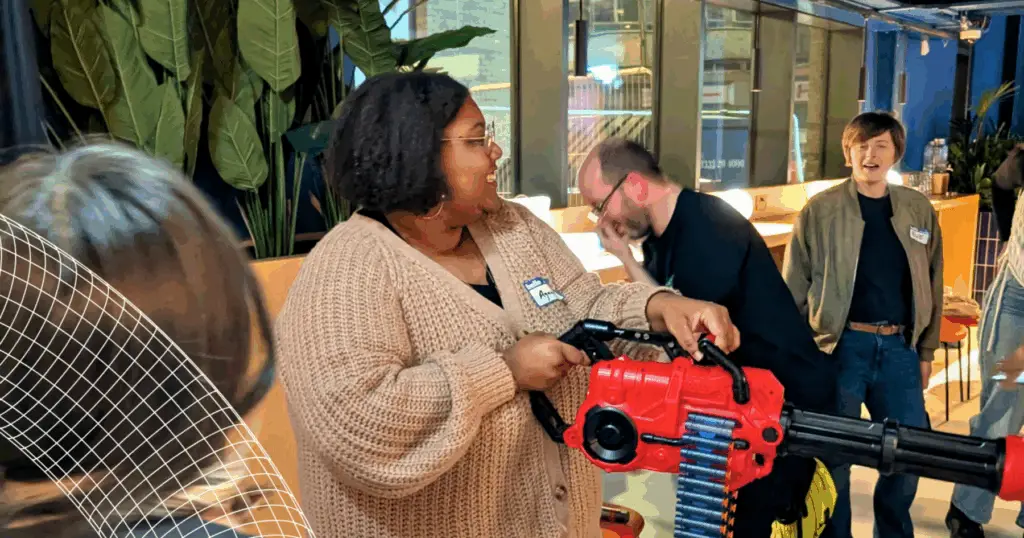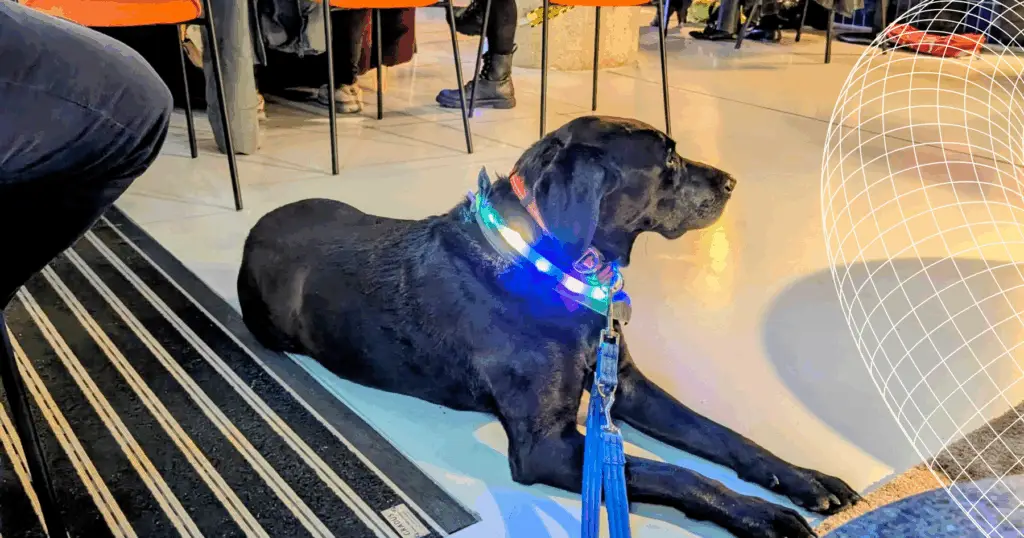

When photographer Greig Middlemiss started Scottish Creative Network in 2009, he had one simple problem: people on the internet were flaky. Really flaky.
“I found that trying to do collaborations online, the amount of people who would say, ‘Yeah, I’m interested. Let’s go and do something,’ and then never show up was brutal,” Greig recalls. “It was something like an 80% fail rate.”
His solution? Get people in the same room and see if they actually gel before committing to work together. What started as 40 photographers, models, and makeup artists sitting around a table has evolved into something far more energetic, and considerably more chaotic.
After a pandemic pause that stretched into years, Greig found himself at Glasgow’s Social Hub with a schedule he finally controlled and a co-conspirator in graphic designer Ross Grubb. When they relaunched in December 2024, 60-70 people showed up.
“I remember thinking, yeah, this could be something quite good,” Ross says. “There were folk in the social hub I’d seen but hadn’t properly spoken to. It was nice connecting with them.”
By February, Ross had officially joined as co-host, and they began adding structure to the evenings: speakers to provide educational value, an open floor for announcements and asks, and (most importantly) what they now call “creative chaos.”

Walk into a typical networking event and you’ll find the usual suspects: name tags, awkward small talk, people huddled in defensive circles nursing glasses of wine. Walk into a Scottish Creative Network meetup and you might find yourself playing peer pong (beer pong without the beer), pass the parcel with mystery prizes, or human bingo where you have to tick off meeting a videographer, photographer, and graphic designer.
“When it feels quite forced, it can be hard,” Greig explains. “The more stupid it is, what happens is that people come away from something and they look at each other and go, ‘What the f*** have we just done?’ It makes no sense. And when you break down that first introduction, people actually just go, ‘Do you know what? Let’s just chat.'”
Ross adds: “We don’t ever want to put anybody on the spot, but we also want to break that barrier, let people let their hair down, let their guard down a little bit, and just embrace a bit of stupidity, a bit of fun.”
It’s an approach born from experience. Both Greig and Ross have done plenty of traditional networking; the kind where you rehearse your 60-second pitch while walking to the venue, where you awkwardly force your way into conversations or desperately try to escape them.
“As creatives, we want to be creative,” Ross says simply.
No discussion of Scottish Creative Network would be complete without mentioning Percy Pigs. The vegan-friendly Marks & Spencer sweets have become the unexpected currency of the open floor session, where attendees can grab the mic for two minutes to share a project, ask for volunteers, or promote their work.
“We just needed to bribe people to come and talk,” Ross laughs. “They’re vegan friendly, and they’re literally 50 feet along the road.”
What started as a practical solution has turned into a running gag… and a point of pride. Greig has done the math: they’ve given away approximately 8.5 kilograms of Percy Pigs.
“That’s a lot of people taking the stage and the microphone from us, which is what we want,” Ross notes.
(Greig and Ross would like Marks & Spencer to know they’re open to sponsorship discussions.)

Ask Greig and Ross about their organising process and you’ll get a sheepish grin. “Do we have processes? We tend to thrive on chaos,” Greig admits.
But there is a rhythm, even if it’s informal. They book guest speakers months in advance (currently lined up through February). They schedule social media posts. And then comes the hardest part: coming up with the next game.
“We always have that text message,” Ross says. “It’ll be like, ‘Greg, I’ve had an idea.’ Or ‘Ross, I’ve had an idea.’ And then us replying being like, ‘Oh s***, what is he thinking? What are we going to do?'”
The pass the parcel concept came during a lunchtime walk. “Why don’t we play pass the parcel? Bring back a nostalgic 90s party game,” Ross suggested. They filled the layers with goodies from favourite local brands and organisations.
Their guiding principle: if it’s easy enough for them to explain, it should be easy enough for 40-50 people to understand. “Sometimes we have loads of ideas and then it’s always that classic line: Greig, we need to simplify it,” Ross says. “I’m a simple guy, so I’m like, let’s keep it simple.”
They’re not above using ChatGPT for inspiration, though rarely for the final idea. “I’m not good with a blank page,” Greig confesses. “Sometimes getting a list of nonsense out of ChatGPT might just be enough to not even go down that route, but it would say, ‘Oh, wait a minute. I’m going to go off on a tangent here.'”
Running monthly events means the cycle never really stops. “It becomes very easy to go, ‘That’s done. Let’s have a couple of weeks off,'” Greig says. “And then you go, ‘Oh s***, there’s only two weeks left.'”
Visibility is the constant challenge. That’s why they commit to what Greig calls “stupid videos”: silly 20-minute productions that get far more engagement than simple announcement posts. “People engage when we do stupid s*** on camera,” he says matter-of-factly.
Ticket sales follow their own rhythm. It’s only £5, so people tend to decide a few days before whether they’re coming. “There’s literally only three tickets gone and you’re feeling the pressure,” Greig notes. “But we still get a good turnout every single month.”
Weather matters. Summer is quieter. But attendance isn’t really how they measure success anyway.

“Atmosphere, vibe, and smiles,” Greig says immediately when asked how they measure success. “You feel it, you know. If people are smiling and having a good time, that’s it. There’s no sales metrics. It’s not the ticket numbers either. As long as it breaks even, that’s absolutely fine.”
The real wins come in unexpected moments. Like the time they went for coffee in the Social Hub and saw two attendees working together. “Did you guys know each other before?” Ross asked. “No, we met at your event,” they replied. “We were like, ‘Yes, that was us that did that.'”
Or when Greig bumped into three people scouting locations for a shoot: a stylist who’d been coming since 2009, a photographer he knew from other networks, and a model he’d worked with years ago. All three had met at Scottish Creative Network.
“That’s what it’s about,” Greig says simply.
Beyond the community building, Scottish Creative Network has transformed both founders in ways they didn’t anticipate.
For Ross, it’s been a crash course in public speaking. “I used to walk from my flat to certain networking events knowing I had to do a 60-second pitch, and in my head I’m rehearsing it,” he admits. “It was just so irrational. There was no point in it.”
The transformation has been gradual but profound. Greig has noticed the physical changes that reveal Ross’s growing confidence. “When you first started, you rooted yourself to the spot. You literally spread your legs like ‘this is me, right?’ And now you’re just relaxed, moving around naturally. That’s a confidence thing.”
Ross can see it himself, looking back at photos from earlier events. What once felt terrifying (standing in front of dozens of people with a microphone) now feels natural. Even when they moved to the Social Hub’s theatre space with its formal seating and stage, rather than their usual intimate living room-style setting, Ross found himself rising to the occasion rather than freezing up.
For both of them, there’s also the visibility factor. “It is nice that we are almost making our own content, and off the back of that there are opportunities for us to be working with people,” Ross says. “It’s exposure, but in an authentic way.”
They’ve become recognisable. People ask, “Are you Ross from SCN?” or “Where’s Greig?” when one shows up at an event without the other. “We’re not Ant & Dec,” Ross laughs.
Greig appreciates the recognition in a different way. “When people start to come to you for something, even if it’s not necessarily what I do as a service. When people come to you to ask you to take part in something, to give an opinion, to be on something, that’s doing yourself a good thing.”

When asked why they chose Forumm for their ticketing, both Greig and Ross light up. The answer isn’t about features or pricing, it’s about shared journey.
“We’re all in the same boat,” Ross explains. “We’re developing. We are building. You can’t do that without the support or the community or the people. You guys are trusting us and we’re trusting you. We want you to use us to help learn and grow and build the platform.”
Like Scottish Creative Network, Forumm is still evolving, still building, still figuring things out. That resonates. “It’s a Scottish business, so it’s great to see people putting their heart and soul into something that they are passionate about,” Ross adds.
Greig cuts to the heart of it: “I love spending time with people who love what they do, who care about what they do. Whether or not you have all the bells and whistles is irrelevant. If you have that first part, then you’re my tribe.”
It’s a philosophy that applies equally to their events, their collaborators, and their choice of partners. Start with passion and care, and the rest will follow.
The requests keep coming: Are you coming to Edinburgh? Are you heading up north?
“We would love to,” Ross says. “But it’s about our limited availability and time.” Still, they’ve discussed the possibility of expanding, maybe even franchising the concept. “We’ve got all the games and resources ready that we know work. We could hand them over or support another city.”
Greig has bigger dreams too. “I’ve talked about it a lot, I have it in my head to bring as many of the creative networks together for one day. Curios, Tectonic, all of those things that do stuff. Smash them together in one place for one day and see what comes out the other end.”
It’s an ambitious vision that would require time and funding. But then again, so did convincing 70 strangers to play peer pong with each other.
In a world drowning in digital connections, Scottish Creative Network is defiantly, joyfully analog. It’s about seeing people face-to-face, playing ridiculous games, earning Percy Pigs, and maybe, just maybe, finding your next collaborator or client in the process.
“The whole thing is about bringing people together and helping each other on our journeys,” Greig says. “That’s felt both ways very much.”
Nearly a year in, with regular attendees, organic collaborations, and 8.5 kilograms of Percy Pigs distributed, they’ve proven one thing: sometimes the best networking happens when you stop trying to network and start playing pass the parcel instead.
Scottish Creative Network meets monthly at Glasgow’s Social Hub. Tickets are £5. Percy Pigs are complimentary (if you brave the open floor). Learn more and register for upcoming events at Forumm.
